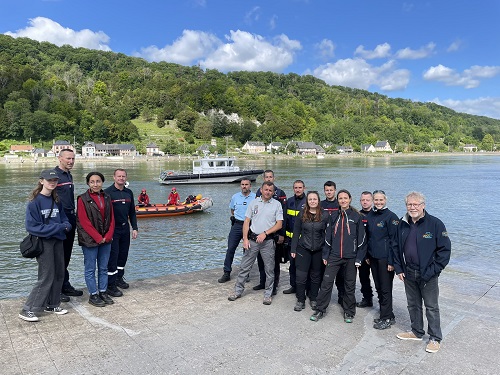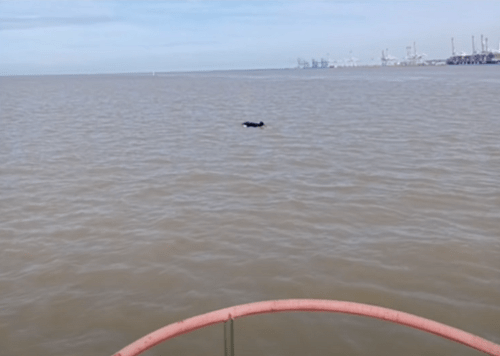A lost killer whale was spotted in the Seine estuary between Rouen and Le Havre and was observed on Wednesday May 25, and the prefecture organized an observation mission with a view to rescuing the animal. Charlotte Curé, a Cerema researcher specializing in bioacoustics, piloted the technical aspects of the operation.
On Wednesday May 25, a killer whale was observed in the Seine by specialists from the Group for the Study of Cetaceans of Cotentin and marine mammals of the Channel Sea (GECC) and the French Office for Biodiversity. The Prefect of Seine-Maritime then organized meetings with various State departments to organize an accurate observation of the animal and determine its state of health as well as possible actions to bring it back to the sea.
A team of experts to observe and save an orca in distress
A group of multidisciplinary experts bringing together GECC, OFB, Cerema/UMRAE, ENSTA Bretagne (National School of Advanced Techniques), NOS (Norwegian Orca Survey), and others biologists specialized in marine mammals as well as a veterinary wildlife specialist has been appointed. Charlotte Curé, researcher specializing in acoustic member of the team from the Joint Environmental Acoustics Research Unit (UMRAE) was responsible for steering the operation on a technical level and acting as technical spokesperson for the media, many of whom followed the mission .
This group has proposed an operation to the services of the State which gave its agreement and mobilized as quickly as possible all the means necessary for the realization of the rescue operation which took place on Saturday May 28. A rescue protocol using acoustic stimulipreviously deployed during a rescue operation in Norway, was reused and adapted to the circumstances.
The operation had two objectives:
- establish a diagnosis of the state of health of the animal
- implement an experimental sound diffusion protocol to incite the killer whale to reach the mouth of the Seine.
It was by using acoustic stimuli and aerial shots that the team was able to locate the killer whale and estimate its state of health. It appeared that the animal was weakened, had abnormal behavior and seemed disoriented. The veterinarian was able to make a diagnosis of mucormycosis, “an emerging disease observed in marine mammals in several places around the world (particularly in North America) without specialists being aware to date of comparable cases in Europe. It is a deep affection of the dermis and skin likely to affect immunocompromised animals“, specifies the prefecture of Seine-Maritime.
This animal was suffering from an advanced stage of the disease, and could not be brought back to the sea, the group of experts was therefore forced to initially adopt the solution of euthanasia.
The group of experts brought together to set up the rescue protocol was ready to continue the operation if the animal had a chance of survival. The animal being in agony (it was clearly doomed in the very short term according to the veterinary expert on site), the welfare of the animal took precedence and the objective could no longer be rescue but to shorten its sufferings. On May 30, he was declared dead. The body of the orca was towed for analysis by veterinarians and biologists, in particular to understand the causes of his health problems and his death.
A large-scale device to observe the animal

Normandy
Of lots of data were collected during the May 28 operation: photos and videos by cameras and drones, recordings of the animal’s vocalizations by hydrophones placed in the water, and visual observations of the behavior by specialized observers.
The experts present on site were able to observe a noticeable lack of liveliness and one atypical and disoriented behavior of the animal (for example round trips from one side of the bank to the other). The acoustic recordings indicate the repetition of a vocalization or a few vocalizations which look like cries of distress emitted repeatedly in situations of intense stress (Figure 1), as has already been characterized in the killer whale or related species such as the pilot whale.
L’health of the animal diagnosed by the veterinarian was alarming: generalized mycosis of the Mucormycosis type. Photos revealed deep ulcerations, deep dermatitis with necrotic lesions. These findings, associated with the animal’s obvious behavioral disorders and the distress signals emitted intermittently, led to the conclusion that the animal’s physiological and behavioral state was very degraded.
The reactions to different sound emission attempts were inconsistent. Some cues elicited an avoidance response (away from the sound source, cryptic behavior). In other cases, the animal seemed to stay in the background, even during the broadcast of stimuli supposed to be “attractive” and aimed at attracting it in the direction of the estuary.
The reactions do not resemble those observed during similar experiments carried out in the same species, whether in a natural or stressful context (eg: similar operation carried out in Norway in 2017 in killer whales stuck in a bay). Several hypotheses can explain this behavior: the fact that the animal is alone (without its social group), of unknown population (choice of sound stimuli “blindly”) whose dialect is unknown, weakened and sick (inability to respond to stimuli ). It is also possible that his cognitive and auditory systems are damaged.
Indeed, the diagnosis established by the veterinarian indicated a deep infection of the dermis and epidermis that could embolize in the blood to reach the kidneys, lungs, heart and brain, this last point being likely to explain the orca behavioral problems.
We would like to give thanks to the author of this write-up for this amazing material
Acoustics: Cerema is piloting the technical component of an emergency intervention to help an orca lost in the Seine estuary
Take a look at our social media accounts and other related pageshttps://nimblespirit.com/related-pages/

